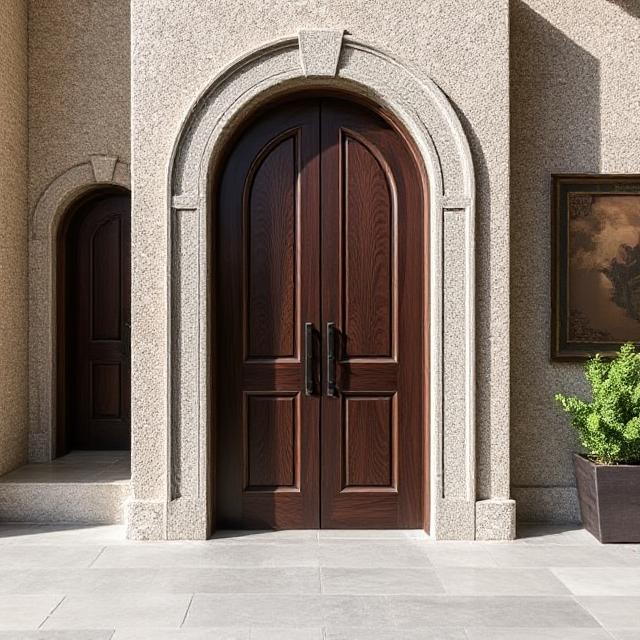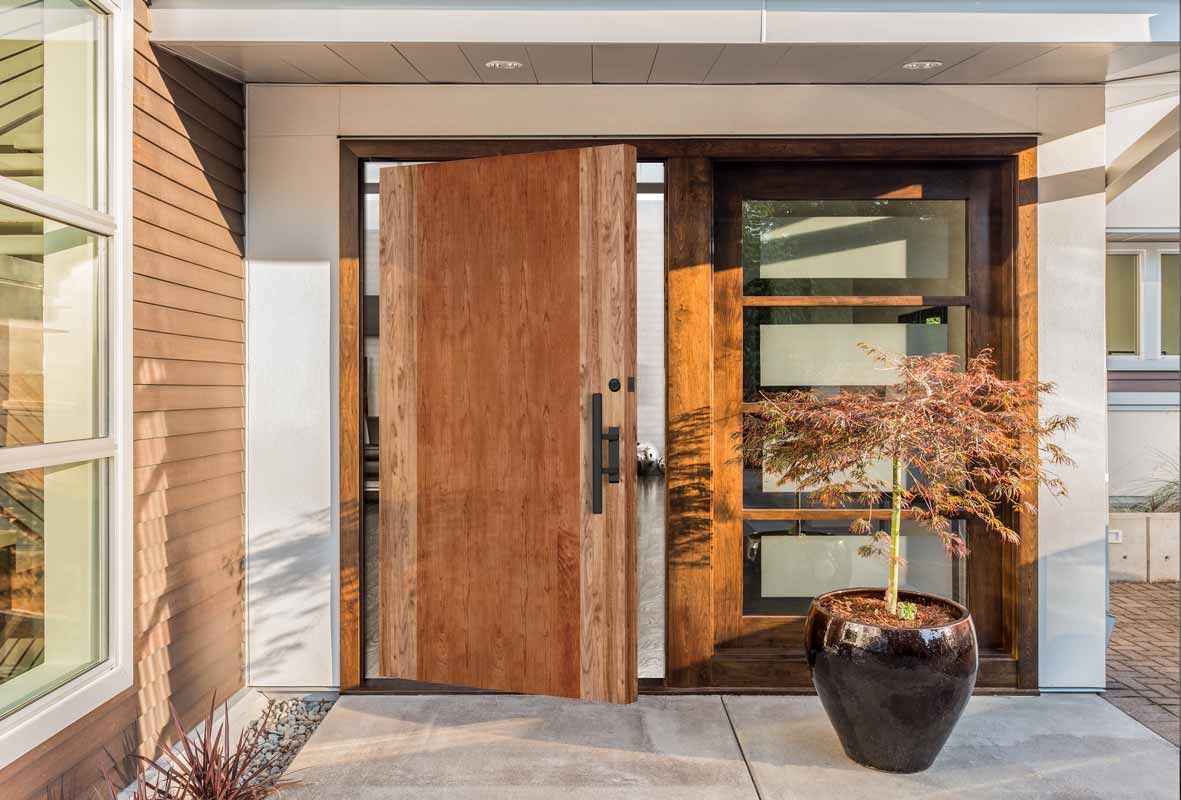A wooden door has a warmth that no other material can quite match. Its grain, tone, and texture tell stories of nature and craftsmanship, which is why many people wonder if such beauty can also serve a practical role at the entrance of a home. The answer is yes—when designed and treated correctly, a wooden door can perform wonderfully as an exterior feature. At our Wooden Door Factory, every piece begins with carefully selected timber and a deep respect for how wood behaves in changing climates. Through protective coatings, precise joinery, and thoughtful design, a door becomes more than a barrier—it turns into a welcoming gesture that endures through wind, rain, and time itself. Choosing the right wooden door means finding harmony between durability and character, a balance that reflects both your style and the soul of the home it protects.
Understanding the Nature of Wooden Doors
What makes wood so special is its living quality—even after it’s shaped into a door, it retains a quiet dialogue with its environment. Each fiber reacts subtly to the air around it, expanding in humid weather and contracting when it’s dry. This natural movement is part of what gives a wooden door its authenticity and charm. You can feel it in the smooth surface, see it in the shifting tones of grain under sunlight, and sense it in the way it warms a room’s atmosphere. Beyond appearance, wood has a natural ability to insulate, helping to regulate interior temperature and reduce outside noise. It creates an inviting threshold that feels solid yet welcoming.
However, this organic nature also means wood can be sensitive. Without the right protection, fluctuating temperatures and moisture can cause gradual changes—tiny cracks, warping, or fading that quietly accumulate over time. Older doors, especially those made before modern coatings and treatments became common, often show these signs after years of exposure. Rain and direct sunlight can draw moisture in or pull it out too quickly, creating stress within the grain. Seasonal cycles of expansion and contraction slowly loosen joints, leading to a door that may no longer fit as neatly within its frame.

Modern craftsmanship has brought forward thoughtful solutions to these challenges. Advanced finishing systems now seal the surface without suffocating the material, allowing wood to breathe while blocking excess moisture. Specialized primers and layered coatings act as flexible shields that move with the door rather than against it. Inside the structure, engineered cores and balanced veneers strengthen stability, minimizing the effects of environmental shifts. Even the way a door is assembled—using precise dowel joints, moisture-controlled adhesives, and multi-directional pressing—contributes to its resilience.
What results is a wooden door that preserves the essence of natural timber but gains the endurance required for exterior use. Instead of fighting against the elements, it adapts gracefully to them. The charm of real wood remains untouched, yet its performance reaches a level that homeowners can rely on year after year. This harmony of nature and innovation is what continues to make wooden doors a timeless choice, bridging the beauty of the past with the technology of the present.
Modern Protective Techniques for Exterior Applications
Taking a wooden door outdoors requires more than simply picking a beautiful piece of timber—it demands a thoughtful approach to protection. Over time, exposure to rain, sunlight, and fluctuating temperatures can wear down even the sturdiest wood. To keep a door looking fresh and performing well, modern exterior wooden doors are treated with several protective techniques that work together to combat the elements.
One of the common methods is the application of a moisture-resistant layer combined with sealant varnish. This creates a barrier that prevents water from penetrating the surface while allowing the wood to retain its natural “breathing” quality. Another critical technique involves ultraviolet (UV) resistant coatings. Sunlight can fade colors and weaken the timber structure over time, and UV-blocking finishes help maintain both color richness and surface integrity. Lastly, anti-corrosion structural treatments strengthen the wood internally, preventing decay and insect damage. These methods not only extend the life of the door but also preserve the natural texture and warmth that make wooden doors appealing.
The benefits of these techniques can be summarized in the following table:
| Finish Type | Primary Function | Added Benefit |
|---|---|---|
| Weather-resistant coating | Prevents moisture absorption | Reduces cracking and warping |
| UV-blocking finish | Shields from sunlight | Maintains natural wood color |
| Anti-corrosion treatment | Protects against decay and pests | Increases structural stability |
By combining these finishes, a wooden door is not just a static barrier but a resilient, enduring feature of a home. The protective layers work in harmony to keep the door functional and visually appealing, ensuring that it continues to welcome guests with its natural charm for many years.
Design Matters: Aesthetic and Structural Adaptation
When it comes to using wooden doors outdoors, design plays a role just as important as material choice or protective finishes. A door isn’t simply a flat panel—it’s a carefully considered composition that balances beauty, strength, and resilience. The style, thickness, and hardware selections all influence how well the door withstands environmental stress while maintaining its visual appeal.
The shape and profile of the door affect not only its aesthetic impact but also its ability to shed water and resist warping. Thicker doors provide greater stability, reducing the likelihood of twisting or bowing under heat and moisture changes. The type of hinges, locks, and handles also matters; quality hardware ensures smooth operation even when the door is exposed to varying weather conditions. Multi-point locking systems and weather-stripping can add both security and protection against drafts or water infiltration.
Structural enhancements can further improve durability. Reinforced stiles and rails, laminated panels, and tongue-and-groove joints work together to stabilize the door and minimize movement caused by seasonal expansion and contraction. These design decisions don’t just extend the door’s lifespan—they preserve its natural elegance and the character of the wood.
Here are some key points to consider when designing exterior wooden doors:
-
Solid core composition: Ensures strength and resistance to environmental stress
-
Elevated threshold design: Prevents water from entering under the door
-
Multi-layer lamination: Adds dimensional stability and reduces warping
-
Protective sealing edges: Shields vulnerable sides and ends from moisture
-
High-quality hardware: Enhances longevity and smooth operation
-
Panel depth and profile choices: Improves both appearance and structural integrity
Through thoughtful design, a wooden door becomes more than a boundary—it turns into a functional work of art, offering lasting performance while complementing the home’s exterior style.
Customization and Personal Expression
One of the aspects of wooden doors is the ability to make them uniquely your own. Today, homeowners increasingly seek customization to reflect personal taste and complement the architectural style of their residence. From selecting a particular wood stain to choosing grain patterns, finishes, and textures, every decision allows the door to convey a distinct character. Carved panels or subtle engravings can add a touch of artistry, while size adjustments ensure a great fit for non-standard openings or grand entryways. Even the choice of door handles, hinges, and other hardware contributes to a cohesive design statement.
Custom wooden doors act as a bridge between the home’s exterior and interior, harmonizing aesthetics with function. For instance, a warm-toned door with natural wood grain can enhance a traditional façade, while a sleek, minimalist design pairs beautifully with modern architecture. By matching color palettes, proportions, and detailing with window frames, siding materials, and surrounding landscaping, the door becomes an integral part of the home’s visual language rather than a separate element.
At our wooden door factory , we embrace this trend by offering a wide range of customizable options. Clients can experiment with finishes, textures, and panel designs to achieve a personalized look that remains durable under outdoor conditions. Our process ensures that every door retains its structural integrity while reflecting the homeowner’s vision. For exterior applications, protective coatings and reinforced cores are seamlessly integrated into the customized design, allowing the door to withstand weather changes without compromising style.
The possibilities are nearly endless: a deep, richly stained door with hand-carved geometric patterns can add grandeur to a classical villa, while a simple, horizontally paneled door with a soft matte finish might suit a contemporary home. Even small details, such as inset glass panels or subtle molding, can elevate the overall aesthetic. By choosing a custom wooden door, homeowners are not just investing in functionality—they are creating an inviting, signature entrance that sets the tone for everything beyond.
Installation and Maintenance Essentials
Installing a wooden door outdoors is more than simply fitting a panel into a frame. A well-installed door provides security, insulation, and long-term durability, while poor alignment or improper sealing can compromise performance and accelerate wear. Attention to detail during installation is key, starting with proper alignment. Ensuring the door sits perfectly plumb and level within the frame prevents stress on hinges and prevents the door from sticking or sagging over time. Even a slight misalignment can cause friction, which over months or years may lead to warping or damage to both the door and frame.
Sealing is another crucial step. Exterior doors must be protected against water infiltration, as moisture can penetrate edges, joints, or even the door surface if left unaddressed. Applying high-quality weatherstripping around the frame and ensuring a tight threshold helps prevent drafts, water seepage, and insect intrusion. Many homes benefit from a small drip cap or overhang above the door, which helps divert rainwater away from the surface and reduces direct exposure to moisture. Proper installation ensures the door remains both functional and visually appealing, maintaining its protective role without compromising its aesthetic charm.
Once installed, maintenance becomes the ongoing key to longevity. Wooden doors, though durable, are living materials that respond to environmental conditions. Regular cleaning helps remove dust, dirt, and pollutants that can degrade finishes over time. Gentle cleaning with mild detergents and soft cloths ensures the surface remains pristine without damaging protective coatings. Periodically, a new layer of protective oil or sealant should be applied, especially in climates with heavy rainfall or strong sunlight. This replenishes the barrier against moisture and UV damage, keeping the door healthy and attractive.
Hardware maintenance is equally important. Hinges, locks, and handles are subject to repeated use and exposure, which can cause to loosening, corrosion, or reduced functionality. Annual checks allow homeowners to tighten screws, lubricate moving parts, and replace worn components before small issues become significant problems. Keeping the bottom threshold dry also minimizes the risk of water absorption, which can cause swelling or warping over time.
Here is a practical checklist for regular wooden door maintenance:
-
Apply protective oil once per season to maintain finish and moisture resistance
-
Keep the bottom threshold dry to prevent water damage and warping
-
Avoid direct sprinklers or excessive heat exposure that can stress the wood
-
Check hinges, locks, and handles annually for wear and lubrication
In addition to these routine practices, it is helpful to inspect the door visually after heavy storms or severe temperature shifts. Look for minor cracks, peeling finishes, or changes in alignment. Early detection allows for prompt touch-ups, preserving both appearance and function. For example, small cracks can be filled with suitable wood filler, and worn sealant can be reapplied without requiring major restoration. Preventative care ensures that a wooden door remains a protective and decorative feature for many years.
Another approach is seasonal care tailored to environmental conditions. In winter or humid seasons, applying a thin layer of wax or oil can help reduce moisture absorption, while in hot, sunny months, ensuring UV-blocking finishes are intact preserves color and surface quality. Many homeowners also find that cleaning and oiling in a consistent schedule creates a simple routine that prolongs the life of the door while keeping it looking inviting.
In addition to routine cleaning and protective treatments, attention to surrounding structures matters. For instance, ensure that gutters, overhangs, and siding direct water away from the door, as pooling or splashing can accelerate deterioration. Maintaining a slight clearance between the bottom of the door and any surface below also allows for proper ventilation and reduces moisture accumulation.
Another helpful checklist focuses on seasonal inspection:
-
Inspect door surface for minor cracks or peeling finishes
-
Reapply sealant or protective coating as needed
-
Check alignment and adjust hinges if the door has shifted
-
Ensure weatherstripping is intact and replacing it if worn
-
Examine threshold and surrounding area for water accumulation
By combining careful installation with consistent maintenance, an exterior wooden door can retain its beauty and functionality for decades. The key lies in respecting the natural qualities of the wood, understanding how it reacts to weather, and applying both protective treatments and practical care measures. With thoughtful attention, a wooden door becomes more than just an entry point; it stands as a durable, welcoming, and stylish feature that enhances the home while remaining resilient against the elements.
Even small routines, like a seasonal oil application or an annual hardware check, accumulate into long-term benefits. The result is a door that retains its warmth, texture, and character year after year, providing a secure and aesthetically pleasing entrance. Whether the home faces heavy rain, intense sun, or fluctuating temperatures, these steps ensure the wooden door continues to serve its purpose without compromising beauty or structural integrity.
Through careful installation, attentive maintenance, and seasonal checks, exterior wooden doors are able to deliver both practical protection and timeless elegance, embodying the ideal balance between function and style.
Innovation in Exterior Door Manufacturing
Wooden doors have evolved far beyond traditional craftsmanship, thanks to modern manufacturing technologies that blend precision, efficiency, and aesthetic appeal. Today’s exterior doors are crafted with tools and techniques that allow for consistent quality, structural reliability, and design flexibility, ensuring that each door performs well under outdoor conditions while maintaining the natural beauty of wood.
One of the advances is CNC (Computer Numerical Control) machining. This technology allows for precise cutting, carving, and shaping of wood components with incredible accuracy. Complex patterns, grooves, and panel designs that once required hours of handwork can now be reproduced consistently across multiple doors. CNC machining also ensures tight tolerances in joints and edges, which reduces gaps, improves insulation, and enhances the door’s overall durability.
Precision joinery is another innovation that strengthens the core structure of exterior doors. Techniques such as laminated stiles and rails, tongue-and-groove panels, and dowel reinforcement create a stable framework that resists warping and twisting. By controlling moisture content during assembly and using engineered adhesives, modern joinery allows doors to withstand environmental fluctuations while preserving the natural aesthetics of the wood.
Automated spray finishing has transformed the way protective coatings are applied. Advanced spraying systems deliver uniform layers of sealants, stains, and UV-blocking finishes, reducing human error and ensuring complete coverage. This method not only enhances durability but also highlights the natural grain and texture of the wood, creating a visually appealing finish that lasts.
These innovations allow manufacturers to offer doors that are both functional and beautiful. Homeowners no longer have to compromise between durability and design; modern exterior doors combine the advantages of both worlds.
Key technological innovations in exterior wooden door production include:
-
CNC machining: Precise shaping, carving, and cutting for consistent quality
-
Precision joinery: Reinforced stiles, rails, and panels for structural stability
-
Laminated and engineered cores: Reduce warping and improve longevity
-
Automated spray finishing: Uniform protective coatings that enhance aesthetics
-
Controlled moisture and adhesive systems: Maintain durability under varying weather
-
Repeatable production processes: Ensure consistent design and functionality across batches
By integrating these techniques, modern wooden doors achieve a balance of elegance, resilience, and practicality. Innovation has made it possible for exterior doors to be not only a protective barrier but also a statement of style and craftsmanship, elevating the role of wood in contemporary architecture.
Bringing Beauty and Durability Together
Wooden doors have always held a special place in architecture, offering warmth, character, and a tactile connection to nature that few materials can match. When carefully designed, treated, and installed, they are fully capable of serving as exterior doors, combining durability with timeless beauty. The natural grain, texture, and color of wood bring a sense of welcome to any entrance, while modern protective finishes and precise craftsmanship ensure that these doors stand strong against the elements for years to come.

At Haibo, we take pride in blending traditional artistry with modern manufacturing techniques. Every door is crafted with attention to structural integrity, aesthetic appeal, and long-term performance. From moisture-resistant coatings to precision joinery and customizable design options, our approach ensures that each wooden door is both a functional barrier and a distinctive statement piece.
Choosing a Haibo wooden door means investing in more than just an entryway—it means selecting a feature that enhances the overall harmony of your home, reflects personal style, and offers enduring value. Whether you are drawn to classic elegance, contemporary minimalism, or something uniquely personal, Haibo provides the expertise, technology, and craftsmanship to make your vision a reality. Explore our range of exterior doors and discover how a carefully designed wooden door can transform your home’s entrance into a lasting impression of beauty and quality.

 English
English русский
русский Français
Français Español
Español bahasa Indonesia
bahasa Indonesia عربى
عربى



